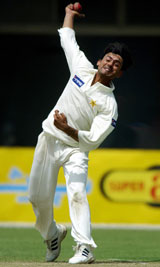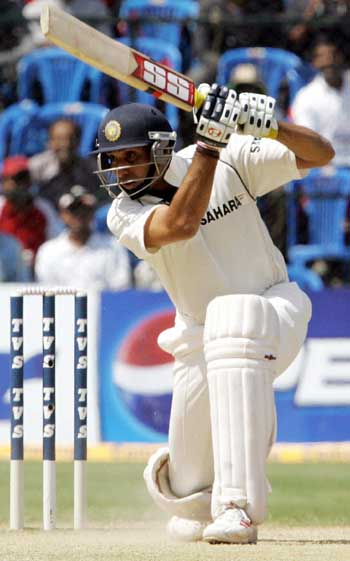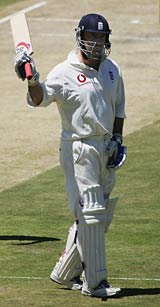Back from the dead
The first batch of readers' submissions of great series fightbacks
05-Sep-2005
Our feature on Great Series Fightbacks evoked a superb response from our readers, and some of the entries that we enjoyed are featured below, along with one from one of our writers. Among those whose contributions we shortlisted but could not publish are Deepak Shah, Vivek Rai, Saad Sultan, Mani Thangadurai , Krishna Kumar, Aditya Deuskar and Prasanna Venkatesh. A common reason for rejection was length - we had asked for submissions between 150 and 250 words, and some of the entries topped 700, which was simply too much. Do continue sending us your pieces on Great Series Fightbacks, but please keep your submissions crisp. We'll edit as necessary for reasons of brevity or style.
|
|

|
Saqlain's magic
S Rajesh on England v Pakistan 2001It was the year of the Ashes, but England had the not-so-insignificant
task of taking care of Pakistan first. With just one session to go in the
two-Test series, it seemed England had handled that challenge pretty well
- they gave Pakistan no chance in the first Test, demolishing them by an
innings and 9 runs. Going into the final session of the second Test, they
were just two down in their second innings, and only needed to bat out
around 30 overs to clinch a well-deserved series win. It seemed a
cakewalk, especially since the dreaded Wasim-Waqar duo hadn't worked their
magic so far - in 113 overs in the series before this innings, the two had
managed seven wickets. Then, it all changed rather dramatically.
Akram got rid of Graham Thorpe and Marcus Trescothick, the centurion,
immediately after tea, before Saqlain Mushtaq took over. Mixing his
offbreaks with a generous dose of the doosras, Saqlain completely
bamboozled the England batsmen in a performance which is, quite
unfortunately, mostly remembered only the number of no-balls he got away
with, courtesy the umpire, David Shepherd. England lost their last six wickets
in 12.2 overs, and what seemed to be perfect preparation for the Ashes
suddenly went pear-shaped.
The Great Wall of Rahul
Sriram Vaidhyanathan on England v India 2002The Indian team's performance, demurely enough, had gone according to
the script thus far. Pummelled out of sight at Lord's and requiring
the services of a cherubic 17-year old debutant to salvage a draw at
Trent Bridge, India proceeded to Headingley with no apparent plan to
combat Michael Vaughan (fresh off his Tendulkar wonderball and bang in
the middle of his career-defining year with the bat), or the England
bowling attack. Perhaps realizing that India had no other choice but
to attempt to win a Test by out-batting the opposition, Ganguly
decided to bat in difficult, overcast conditions at Leeds, desperately
hoping that his batsmen could ride out the storm on the opening day.
Rahul Dravid promptly obliged. Coming off a rearguard century in the
previous Test, he began to blunt the England attack, the bowlers'
annoyance growing with every soul-destroying leave and block. Sanjay
Bangar proved the perfect foil, and India survived the opening day
with only two wickets lost. The next day, Ganguly and Tendulkar
completed centuries, but the danger that had been ever-present on the
first day was now a speck in the distance as India marauded their way
to an imposing 628. Vaughan's form was effectively thrown out of the
equation, as Kumble and Harbhajan Singh combined well over the next
few days to bowl the Englishmen out twice to claim India's
largest-ever victory on foreign soil. The real hero of the match had
been Dravid - luckily for India, Headingley 2002 was only to prove a
warmup for Adelaide 2003 and Rawalpindi 2004.
The final Test of the series proved to be a rain-affected batathon,
but India could lay claim to coming away with series honors on points
after a calculated fightback from their celebrated batting stars. A
drawn series was undoubtedly a result no one could have foreseen after
the Lord's debacle a couple of weeks earlier, and India was slowly,
but surely, erasing the widespread belief that they were only
competitive when playing at home.
|
|

|
Back from the dead
Kunal Ganju on India v Australia 2000-01When Steve Waugh's Australian team arrived in India they were on a mission - a mission to conquer their final frontier and to prove beyond all doubt that they could beat anyone anywhere. But they were met by a talented Indian side who hadn't been properly briefed on the Australian script. India until then, and probably since then as well, were known to crumble when under pressure. And with India beaten by 10 wickets in the first Test at Mumbai, and following on 274 behind Australia in the second Test at Kolkata, the final frontier was all but conquered. But then the tide turned.
Four down in the second innings and still in arrears; then came the partnership that every Indian watched, or claims to have watched! Rahul Dravid and VVS Laxman put on 376 sublime runs as India put together Comeback Number 1. Chasing an improbable 384 to win in less than a day Australia were looking comfortable at 161/3 when Harbhajan Singh and Sachin Tendulkar picked up the remaining 7 wickets in just under 20 overs and India had staged Comeback Number 2 and had leveled the series. And for only the third time in cricketing history had a team won a Test after following on. Remarkably Australia was at the wrong end at each of these 3 occasions.
But there was more to come. In the third Test Australia batted first and were 326 for 3 at the end of the first day. Comeback Number 3 and that man Harbhajan restricted them to 391. India managed a 110 run first-innings lead inspired by the talismanic Sachin Tendulkar and were set an apparently gettable 155 to win in the fourth innings. They just about got there with two wickets to spare and had set the record for the highest succesful chase at Chennai.
Having been 1-0 down and following on, India clawed their way back to win this enthralling series. Harbhajan Singh took 28 wickets in the last 2 matches, VVS Laxman scored India's highest individual score, and Mathew Hayden arrived at the international stage but what mattered was that Australia's final frontier remained unconquered, and for a while at least India began to believe that they could win despite the odds.
Chin music? What chin music?
Sandeep Sanyal on Australia v India 2003-04The greatest series fightback was at Brisbane in 2003 involving India and Australia. This was the first Test of the series and even though it ended in a draw, the events that unfolded during its course set the tone for one of the best series ever witnessed. India had
been whitewashed during their previous tour to Australia in 1999-2000 under
Sachin Tendulkar. When this team under Sourav Ganguly landed there,
sceptics were debating whether India would receive a 3-0 or 4-0 drubbing. Events were going on its usual course as Australia posted 323 thanks to a century from Justin Langer, and India were in trouble at 62 for 3 when Tendulkar was given LBW under controversial circumstances by Steve Bucknor.
What followed turned the series on its head and shatter preconceived notions about the Indians surrendering meekly. Ganguly led by example and scored a brilliant
144 off 196 balls, supported superbly by VVS Laxman, who scored 75. Together they set the tone for India's domination of Australia in the rest of the
series. He was impeccable in his stokeplay and shot selection, and all
the hype about "chin music" created so typically by the Australian media
before the series disappeared into thin air. India showed the world that
the mighty can be put down to dust in their own backyard.
Defying destiny
Angshuman Hazra on Pakistan v Sri Lanka 1995-96An unfancied Sri Lankan team went to Pakistan for a three-Test series in 1995. Even as a 20-year-old keen follower of Test cricket around the world, I could hardly go through the final day's match report when Sri Lanka lost the first Test at Peshawar by an innings to a strong home side boasting of Saeed Anwar, Aamir Sohail, Inzamam-ul-Haq, Moin Khan, Waqar Younus, Wasim, Aaqib Javed and a new spinner, Saqlain Mushtaq.
Next came the Test match at Faisalabad where Sri Lanka were sent in to bat first. An all-too-familiar collapse and first-innings deficit of 110 runs later, I could already visualise the predictable soon-to-come sports pages. Then, buoyed by Aravinda de Silva's century and some useful later order runs by Chaminda Vaas and Kumar Dharmasena, Sri Lanka scored 361 in their second innings and set Pakistan a target of 252. The soon-to-be-famous Vaas-Murali-Dharmasena trio then reduced the home team to 129 for 6, and to 209 all out after a typical never-say-die 50 by Moin.
The famed unpredictability of the Pakistani side prevented any hype about the third Test at Sialkot as a decider. Surely the wounded home team were about to bite back and clinch the series. The minnows were least expected to be the first team ever who would win a 3 Test series from 0-1 down. Sri Lanka stuttered again, getting only 232 after choosing to bat. Pakistan, however, did worse, and conceded a slender but significant 18-run lead.
Soon the destiny-defying Sri Lankans were repeating their feat of riding a good second-innings score to build a barrier of 357 between history and a Pakistan win. They eventually won by 144.
In retrospect, Tillekaratne's first innings 115 at Faisalabad, which was more than half the team's total, is a knock of invaluable significance to Sri Lankan cricket. A few months on Sri Lanka would be returning from a tough trip in Australia stronger, wiser and (even more) united. In simple words, good enough to lift the 1996 World Cup. I wonder if any World-Cup winning team ever had a better build-up to the big event than this bunch.
|
|

|
Battling the heat
Alan Bone on Sri Lanka v England 2000-01Nasser Hussain's England side appeared to have no chance of winning on the dust bowls in Sri Lanka in 2000-01. True to expectation, Sri Lanka won the first Test by an innings and 28 runs with the enigmatic Marvin Attapattu amassing an unbeaten double-century as Sri Lanka compiled 470 for 5 declared. Despite a century opening partnership between the solid Mike Atherton and the emerging Marcus Trescothick, England's middle order collapsed at the hands of the wily offspinner Muralitharan and the left-arm dart bowling of Jayasuriya. Following on 227 runs adrift, they were routed for a mere 189, with a little help from some incompetent umpires, to give England an old fashioned thrashing.
In the intense heat of Kandy, Hussain's tenacious side fought back well with Darren Gough and Andy Caddick sharing eight wickets on a quicker pitch in Sri Lanka's first innings 297, with Mahela Jayawardene making a fine hundred. England gained an all-important first-innings lead of 90 with the bad luck that had plagued Hussain's batting for more than a year finally rolling in the England captain's favour as he compiled a superlative 109, together with useful contributions from the nudging Graham Thorpe and the fighting Alec Stewart. After a disastrous start to their second innings, Sri Lanka reached the relative heights of 250 with poor umpiring this time conspiring against the home side. It was nip and tuck for England in pursuit of 161. Thorpe was again instrumental in their success with 46 but it was the cool heads of Craig White and Ashley Giles that ensured the series was levelled up at 1-1, England scraping home by 3 wickets.
It all meant much anticipation for the final Test in Colombo. Yet again, Sri Lanka had the good fortune to win the toss but were disappointed to only reach 241 on a good pitch, Robert Croft and Giles sharing 6 wickets. Needing a decent first-innings score, England were undone by the swing of the much underrated Charminda Vaas who took 6 for 73. A first innings lead of 8 was paltry and owed everything to perhaps the finest century of Graham Thorpe's career, an unbeaten 113 compiled in suffocating heat. What followed defied belief, logic and expectation. Sri Lanka collapsed to 81 all out in two hours of mayhem with Giles taking 4 for 11 after Gough and Caddick had destroyed an increasingly brittle top order. Chasing a mere 74 to clinch the series, Sri Lanka reduced England to 43 for 4 with Muralitharan and Jayasuriya achieving prodigious turn off the wicket. Thorpe was the catalyst with 32 not out, showing once more his expertise on turning pitches. England had gone where even the mighty Australian side had not gone before, winning a series in Sri Lanka, where heat, pitches and conditions were as far removed from a cold May day at Lord's as could be imagined.
Write to us with more accounts of great series fightbacks.